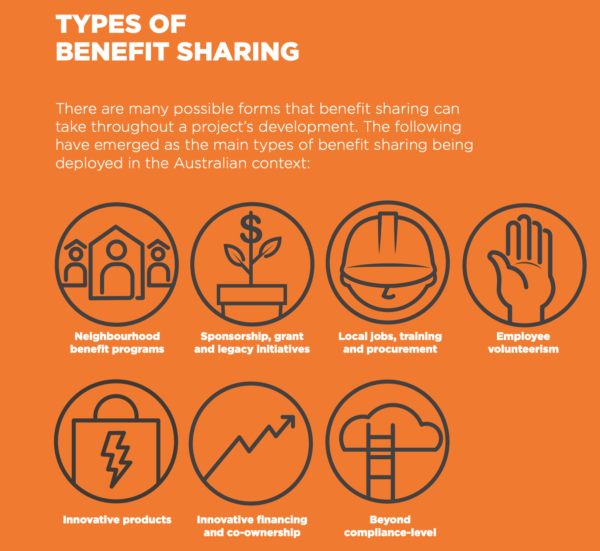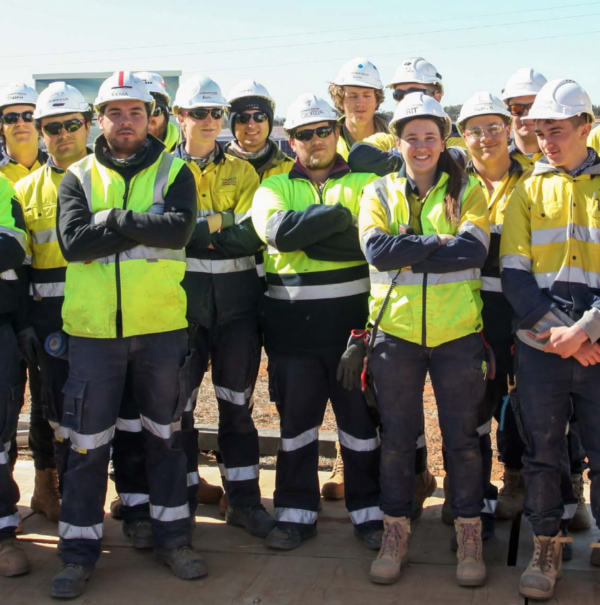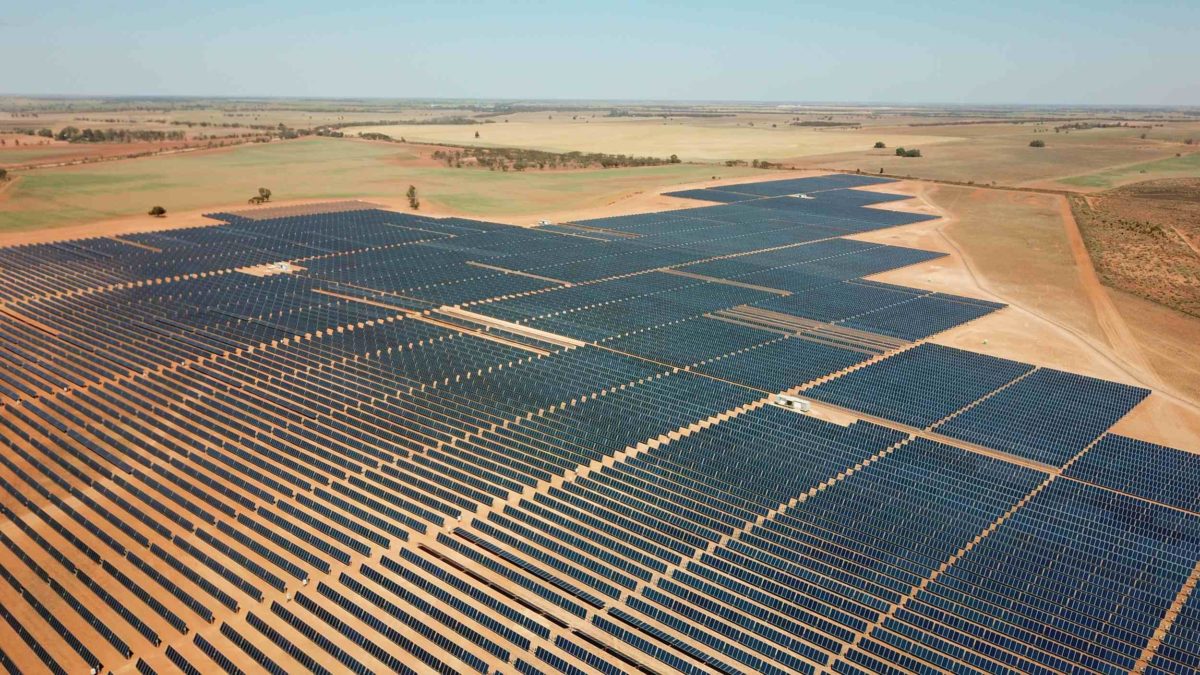Launched at the All Energy Australia conference last week, A Guide to Benefit Sharing Options for Renewable Energy Projects is the latest Clean Energy Council report, which clearly lays out leading practice for boosting local communities through engagement with large-scale projects in their backyards.
The ARENA-funded Guide is not just about jobs creation, although employment is one of the greatest regional benefits conferred by big solar and big wind farms.
In his opening address to All Energy, CEC CEO Kane Thornton cited the “Over $25 billion worth of investment in large scale renewable energy,” to date, and the current commitment of over 16 GW of new capacity under construction and committed, “creating over 14,000, new jobs right throughout rural and regional Australia, in parts of the country where frankly there are few other economic opportunities at play”.
Nor is the Guide just a string of inspiring case studies, such as the solar bulk-buy scheme initiated by Canadian Solar at its 121 MW Carwarp Solar Farm south of Mildura in Victoria: “The region is a drought-impacted dryland farming zone with an excellent solar resource,” explains the Guide. To share the benefits of hosting a solar farm, Canadian Solar is partnering with local solar installers to coordinate the bulk buy and installation of solar PV on nearby residences.
The Guide recommends that renewable developers discover what communities care about and collaborate to make a difference in those areas: at 85 MW Winton Solar Farm in Victoria, for example, developer FRV “identified a strong local legacy of protecting the Regent Honey Eater”, a local bird species impacted by shrinking habitat. One pillar of FRV’s benefit-sharing model is to deliver significant new screening and biodiversity plantings in collaboration with local volunteers.

Graphic: Clean Energy Council
Co-authors of the report — Akin Consulting’s Taryn Lane and Dr Jarra Hicks from the Community Power Agency — have each researched and written widely about how to enhance the positive social outcomes of large-scale renewable energy projects.
In the introduction to this work, they write, “The guide is intended as a practical tool to assist project proponents, financiers, policy makers and communities in understanding the range of benefit-sharing methods available.”
The nitty gritty of co-investment
A section on “Innovative financing and co-ownership” includes approaches, governance and regulatory considerations, and an outline of the benefits of using various platforms designed to facilitate and simplify the rolling out of co-investment models.
DomaCom Fund, for example, was the partner chosen by CWP Renewables to enable its innovative Sapphire Wind Farm Community Co-investment program.
Developed to “fractionalise” large assets into affordable investment parcels that would be accessible to mum-’n’-dad investors, DomaCom is a registered managed investment scheme under the Corporations Act and The Australian Securities Investment Commission and holds an Australian Financial Services License.
“The clear benefit of the platform,” say the authors, “is that it provides strong due diligence and removes the need for a community investment vehicle,” thereby eliminating the requirement for “a long-term community administration and governance role”.
Budgets and timelines
In a concise chapter on “Context and community” the Guide provides frameworks for considering such fundamental questions as, “How much is appropriate?” when it comes to benefit sharing.
It tackles the coming need for infrastructure build out and how to engage communities in managing the hosting of new transmission towers and lines.
Also helpfully and cogently constructed are sections on how to calculate a budget that encompasses numerous aspects of benefit sharing; and a timeline for engaging communities to allow ample consultation, skills development, advertising to give local business notice for tendering and delivery of services, and so on.
FRV’s 56 MW Moree Solar Farm, a virtual elder of the industry, which began exporting to the grid in early 2016, appointed a local liaison officer just after the site was deemed feasible, to help integrate the project into the lives and aspirations of the community. The liaison officer’s local knowledge and connections identified opportunities for benefit sharing that made sense within the particular context of northern rural New South Wales.
Social license to operate
Thornton reminds the industry in his foreword to the Guide, that renewable energy has enjoyed strong public support in Australia, which has formed a “powerful foundation for our transition to a clean energy future”, but that such support cannot be taken for granted. Rather, he says, it will be “shaped by the way that each and every project engages and operates within their local communities”.
Regional Australia faces significant challenges; to recognise those challenges and meet the community in designing solutions builds goodwill and enduring relationships.
The Guide describes a particularly well-considered approach implemented at BayWa r.e.’s 112 MW Karadoc Solar Farm. The developer tasked EPC contractor Beon Energy Solutions with developing a strategic employment and training program in the Mildura community. Its principles were: to hire local; to provide employment opportunities for people facing barriers to employment; and to provide training and support to young people that would enable them to develop skills for a potential career in the solar industry.

Image: Clean Energy Council
Beon started in plenty of time to train some 158 community members into roles in solar farm construction and maintenance. The program involved Mildura’s SuniTAFE in providing training and certification for a number of electrical apprentices. Several of these employees worked on Karadoc Solar Farm before going on to apply their skills at nearby Yatpool Solar Farm, also built by Beon.
Building a future workforce, and lifting local prospects and economies embeds renewable energy as a force for positive change. Read all about it.
This content is protected by copyright and may not be reused. If you want to cooperate with us and would like to reuse some of our content, please contact: editors@pv-magazine.com.









By submitting this form you agree to pv magazine using your data for the purposes of publishing your comment.
Your personal data will only be disclosed or otherwise transmitted to third parties for the purposes of spam filtering or if this is necessary for technical maintenance of the website. Any other transfer to third parties will not take place unless this is justified on the basis of applicable data protection regulations or if pv magazine is legally obliged to do so.
You may revoke this consent at any time with effect for the future, in which case your personal data will be deleted immediately. Otherwise, your data will be deleted if pv magazine has processed your request or the purpose of data storage is fulfilled.
Further information on data privacy can be found in our Data Protection Policy.